Simulation of Hydrological Processes in the Jing River Basin Based on the WEP Model
Abstract
:1. Introduction
2. Materials and Methods
2.1. Study Area
2.2. Datasets
2.2.1. Meteorological Data
2.2.2. Hydrological Data
2.2.3. Other Data
2.3. WEP Model
- (1)
- Model Features
- (2)
- Model Principles
- (3)
- Model Parameters
3. Results
3.1. WEP Model Construction
3.2. Parameter Calibration
3.3. Model Simulation Results and Evaluation
3.4. Spatial Distribution Characteristics of Key Hydrological Cycle Elements
4. Discussions
5. Conclusions
Author Contributions
Funding
Conflicts of Interest
References
- Jiao, L.; Lu, N.; Fang, W.; Li, Z.; Wang, J.; Jin, Z. Determining the independent impact of soil water on forest transpiration: A case study of a black locust plantation in the Loess Plateau, China. J. Hydrol. 2019, 572, 671–681. [Google Scholar] [CrossRef]
- Jin, Z.; Guo, L.; Lin, H.; Wang, Y.; Yu, Y.; Chu, G.; Zhang, J. Soil moisture response to rainfall on the Chinese Loess Plateau after a long-term vegetation rehabilitation. Hydrol. Process. 2018, 32, 1738–1754. [Google Scholar] [CrossRef]
- Jian, S.; Wu, Z.; Hu, C.; Zhang, X. Sap flow in response to rainfall pulses for two shrub species in the semiarid Chinese Loess Plateau. J. Hydrol. Hydromechanics 2016, 64, 121–132. [Google Scholar] [CrossRef]
- Youssef, M.A.; Liu, Y.; Chescheir, G.M.; Skaggs, R.W.; Negm, L.M. DRAINMOD modeling framework for simulating controlled drainage effect on lateral seepage from artificially drained fields. Agric. Water Manag. 2021, 254, 106944. [Google Scholar] [CrossRef]
- Yu, Q.; Kang, S.; Hu, S.; Zhang, L.; Zhang, X. Modeling soil water-salt dynamics and crop response under severely saline condition using WAVES: Searching for a target irrigation volume for saline water irrigation. Agric. Water Manag. 2021, 256, 107100. [Google Scholar] [CrossRef]
- Tian, F.; Feng, X.; Zhang, L.; Fu, B.; Wang, S.; Lv, Y.; Wang, P. Effects of revegetation on soil moisture under different precipitation gradients in the Loess Plateau, China. Hydrol. Res. 2017, 48, 1378–1390. [Google Scholar] [CrossRef]
- Simunek, J.; Van Genuchten, M.T.; Sejna, M. Recent Developments and Applications of the HYDRUS Computer Software Pack-ages. Vadose Zone J. 2016, 15, vzj2016.04.0033. [Google Scholar] [CrossRef]
- Bai, X.; Jia, X.; Jia, Y.; Hu, W. Modeling long-term soil water dynamics in response to land-use change in a semi-arid area. J. Hydrol. 2020, 585, 124824. [Google Scholar] [CrossRef]
- Richards La, W.C. Soil water and plant growth. Soil Phys. Cond. Plant Growth 1952, 2, 74–253. [Google Scholar]
- Zhang, C.; Wang, Y.; Jia, X.; An, Z. Variations in capacity and storage of plant-available water in deep profiles along a re-vegetation and precipitation gradient. J. Hydrol. 2020, 581, 124401. [Google Scholar] [CrossRef]
- Laio, F.; Porporato, A.; Ridolfi, L.; Rodriguez-Iturbe, I. Plants in water-controlled ecosystems: Active role in hydrologic processes and response to water stress-II. Probabilistic soil moisture dynamics. Adv. Water Resour. 2001, 24, 707–723. [Google Scholar] [CrossRef]
- Li, X.; Shao, M.; Jia, X.; Wei, X. Profile distribution of soil–water content and its temporal stability along a 1340-m long transect on the Loess Plateau, China. Catena 2016, 137, 77–86. [Google Scholar] [CrossRef]
- Zastrow, M. China’s tree-planting could falter in a warming world. Nature 2019, 573, 474–475. [Google Scholar] [CrossRef] [PubMed]
- Seyfried, M.S.; Schwinning, S.U.; Walvoord, M.A.; Pockman, W.T.; Newman, B.D.; Jackson, R.B.; Phillips, F.M. Ecohydrological control of deep drainage in arid and semiarid regions. Ecology 2005, 86, 277–287. [Google Scholar] [CrossRef]
- Li, H.; Si, B.; Li, M. Rooting depth controls potential groundwater recharge on hillslopes. J. Hydrol. 2018, 564, 164–174. [Google Scholar] [CrossRef]
- Hu, W.; Biswas, A.; Si, B.C. Scale-specific control of soil water storage using multivariate empirical mode decomposition. In Proceedings of the 5th Global Workshop on Digital Soil Mapping, Sydney, Australia, 10–13 April 2012; pp. 139–144. [Google Scholar]
- Jia, X.; Shao, M.A.; Zhang, C.; Zhao, C. Regional temporal persistence of dried soil layer along south-north transect of the Loess Plateau, China. J. Hydrol. 2015, 528, 152–160. [Google Scholar] [CrossRef]
- Western, A.W.; Grayson, R.B.; Blöschl, G. Scaling of Soil Moisture: A Hydrologic Perspective. Annu. Rev. Earth Planet. Sci. 2002, 30, 149–180. [Google Scholar] [CrossRef]
- Wang, T.; Liu, Q.; Franz, T.E.; Li, R.; Lang, Y.; Fiebrich, C.A. Spatial patterns of soil moisture from two regional monitoring networks in the United States. J. Hydrol. 2017, 552, 578–585. [Google Scholar] [CrossRef]
- Jia, X.; Zhu, Y.; Luo, Y. Soil moisture decline due to afforestation across the Loess Plateau, China. J. Hydrol. 2017, 546, 113–122. [Google Scholar] [CrossRef]
- Su, H.; Jia, Y.; Liu, H.; Li, Y.; Du, J.; Niu, C. Runoff evolution simulation and attribution analysis in cold region basin based on WEP-L model. J. Glaciol. Geocryol. 2021, 43, 1523–1530, (In Chinese with English abstract). [Google Scholar]
- Gan, Y.; Zhao, S.; Zheng, L. A distributed hydrological model considering the influence of two flow regions and its application. China Rural. Water Hydropower 2023, 3, 8–20, (In Chinese with English abstract). [Google Scholar]
- Zhou, Z.; Liu, J.; Yan, Z.; Wang, H.; Jia, Y. Attribution analysis of natural river runoff evolution in Yellow River Basin. Adv. Water Sci. 2022, 33, 27–37, (In Chinese with English abstract). [Google Scholar]
- Fan, Y.; Miguez-Macho, G.; Jobbágy, E.G.; Jackson, R.B.; Otero-Casal, C. Hydrologic regulation of plant rooting depth. Proc. Natl. Acad. Sci. USA 2017, 114, 10572–10577. [Google Scholar] [CrossRef]
- Guillod, B.P.; Orlowsky, B.; Miralles, D.G.; Teuling, A.J.; Seneviratne, S.I. Reconciling spatial and temporal soil moisture effects on afternoon rainfall. Nat. Commun. 2015, 6, 6443. [Google Scholar] [CrossRef] [PubMed]
- Rewald, B.; Meinen, C.; Trockenbrodt, M.; Ephrath, J.E.; Rachmilevitch, S. Root taxa identification in plant mixtures – current techniques and future challenges. Plant Soil 2012, 359, 165–182. [Google Scholar] [CrossRef]
- Askar, M.H.; A Youssef, M.; Chescheir, G.M.; Negm, L.M.; King, K.W.; Hesterberg, D.L.; Amoozegar, A.; Skaggs, R.W. DRAINMOD Simulation of macropore flow at subsurface drained agricultural fields: Model modification and field testing. Agric. Water Manag. 2020, 242, 106401. [Google Scholar] [CrossRef]
- Liu, Y.; Gu, Y.; Liu, Y.; Ma, X. Hydrometeorological evolution and its change attribution in Jinghe. Water Resources and Hydro-power Engineering 2023, 6, 6, (In Chinese with English abstract). [Google Scholar]
- Chen, W.; Hou, Z.; Wu, L.; Liang, Y.; Wei, C. Evaluating salinity distribution in soil irrigated with saline water in arid regions of northwest China. Agric. Water Manag. 2010, 97, 2001–2008. [Google Scholar] [CrossRef]
- Khan, M.D.; Shakya, S.; Vu, H.H.T.; Ahn, J.W.; Nam, G. Water Environment Policy and Climate Change: A Comparative Study of India and South Korea. Sustainability 2019, 11, 3284. [Google Scholar] [CrossRef]
- Sun, M. Evaluation of Ecohydrological Effect and Optimization and Regulation of Vegetation Suitability Pattern in Jinghe River Basin, Loess Plateau. Ph.D. Thesis, Northwest A&F University, Xianyang, China, 2022. [Google Scholar]
- Mao, Z.W. Study on Plant Available Soil Water Storage and Carrying Capacity of Vegetation in Jinghe River Basin. Master’s Thesis, Zhengzhou University, Zhengzhou, China, 2023. [Google Scholar]

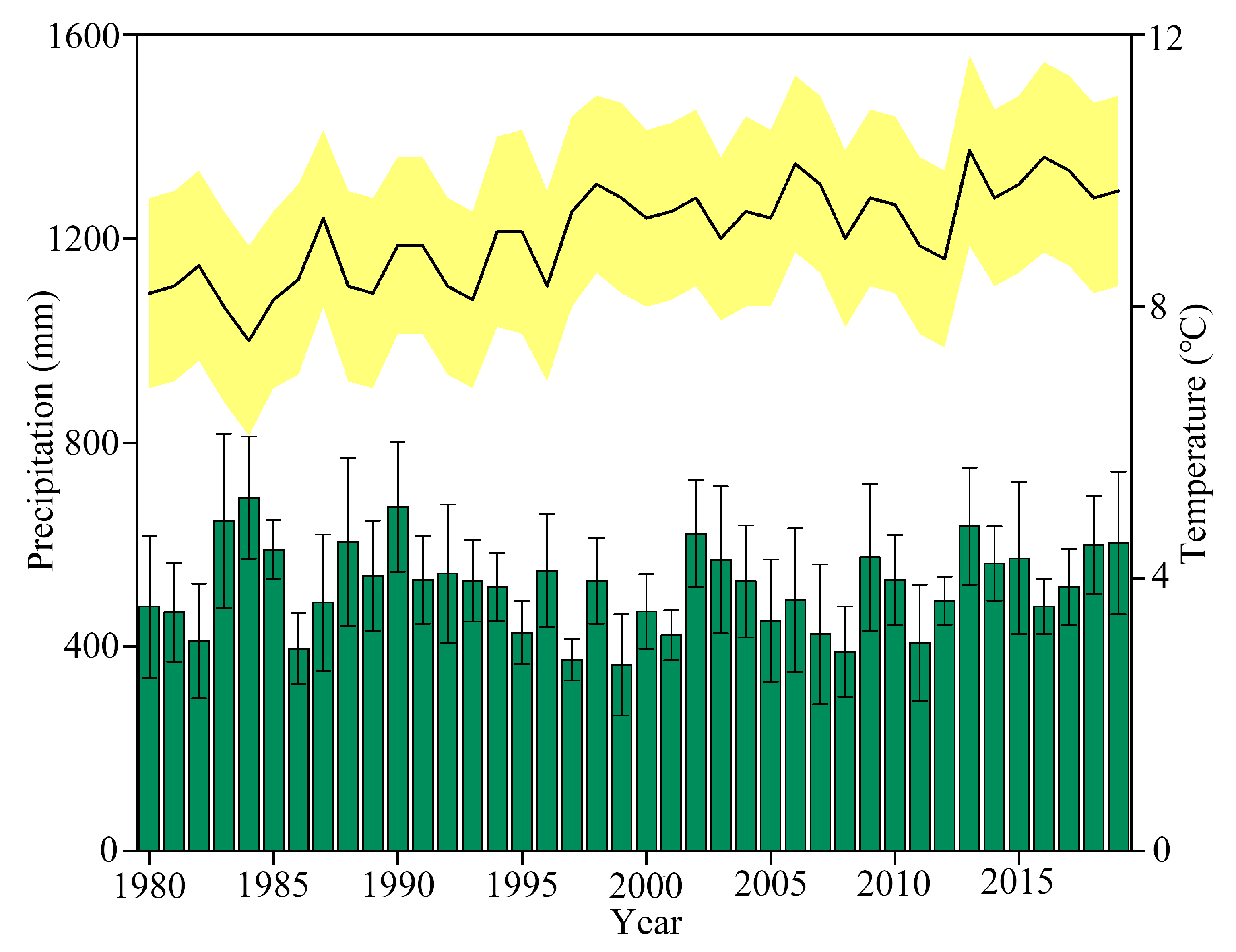

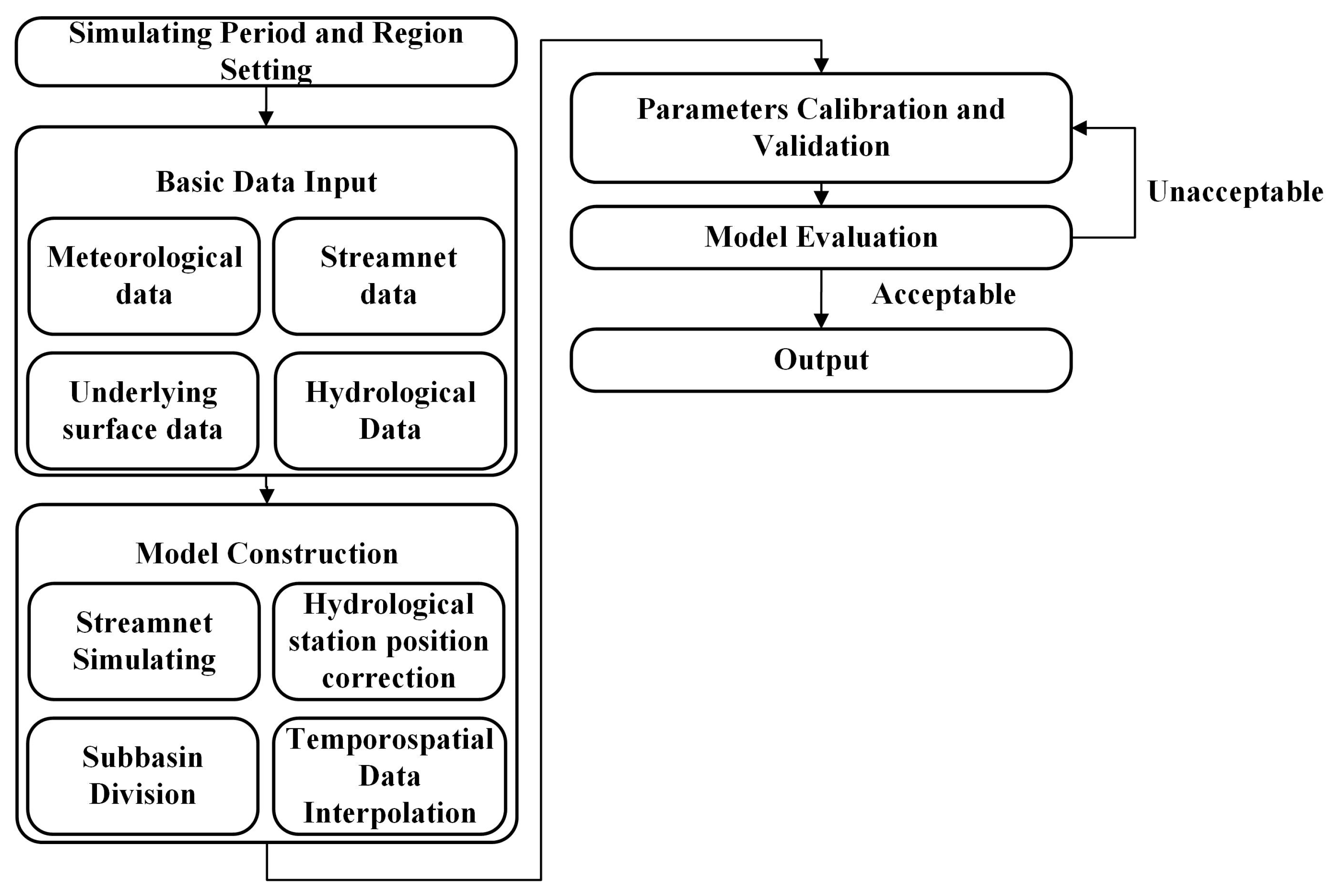

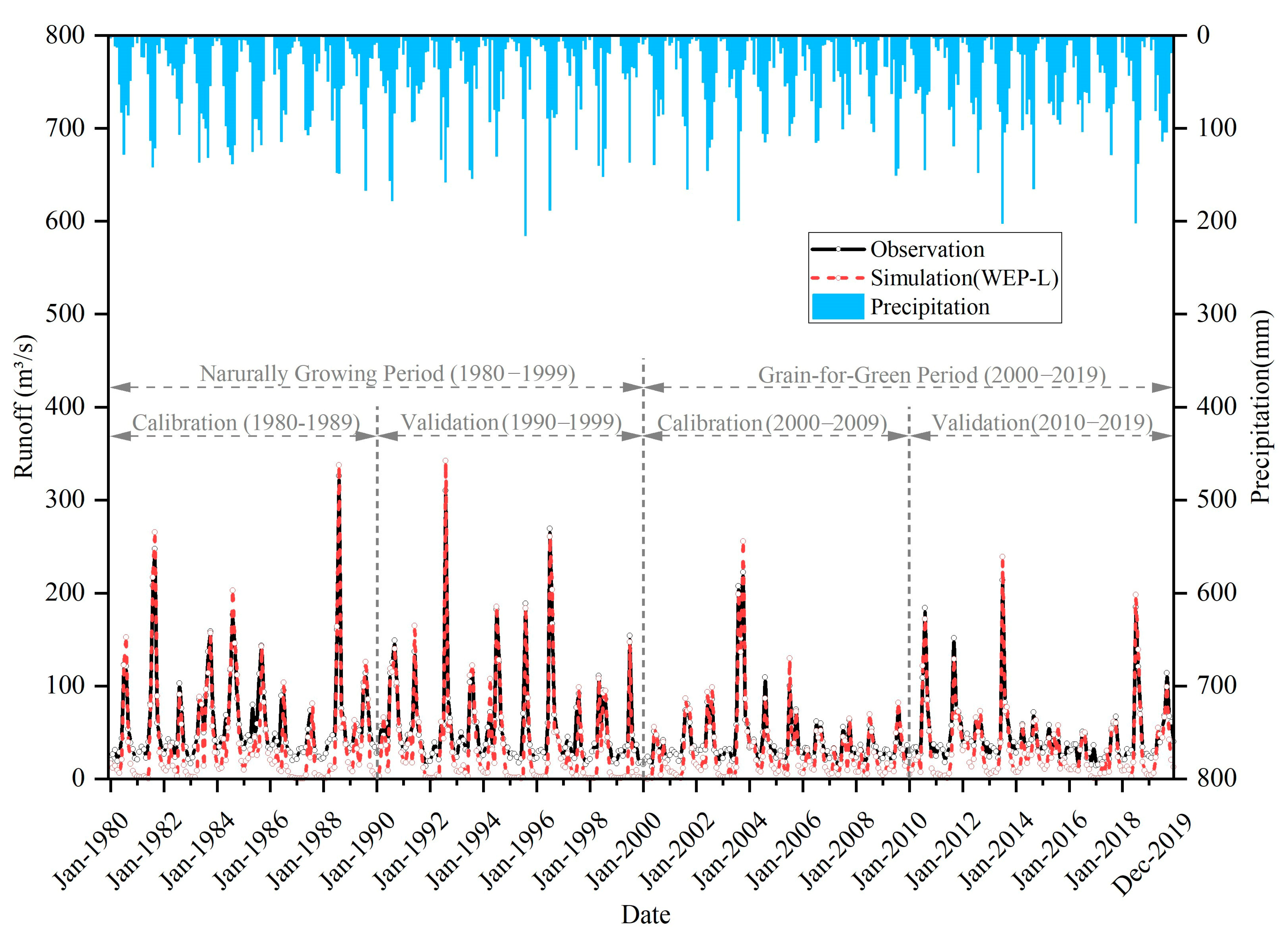
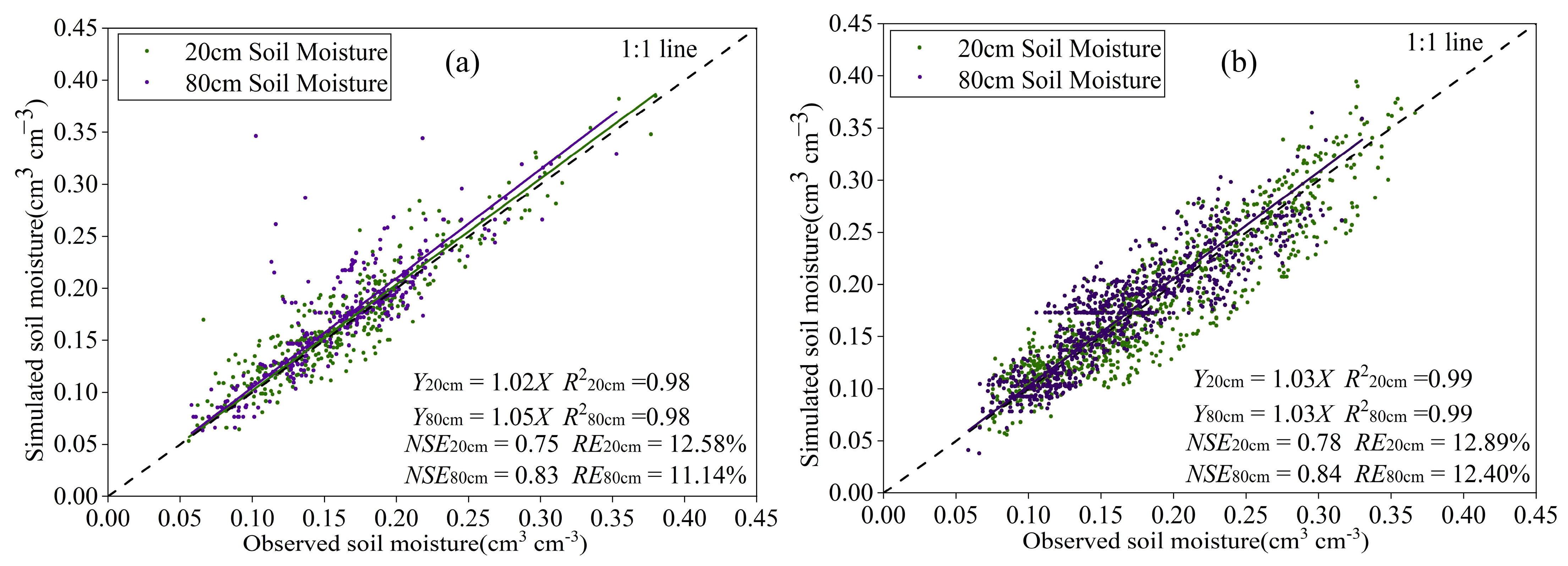
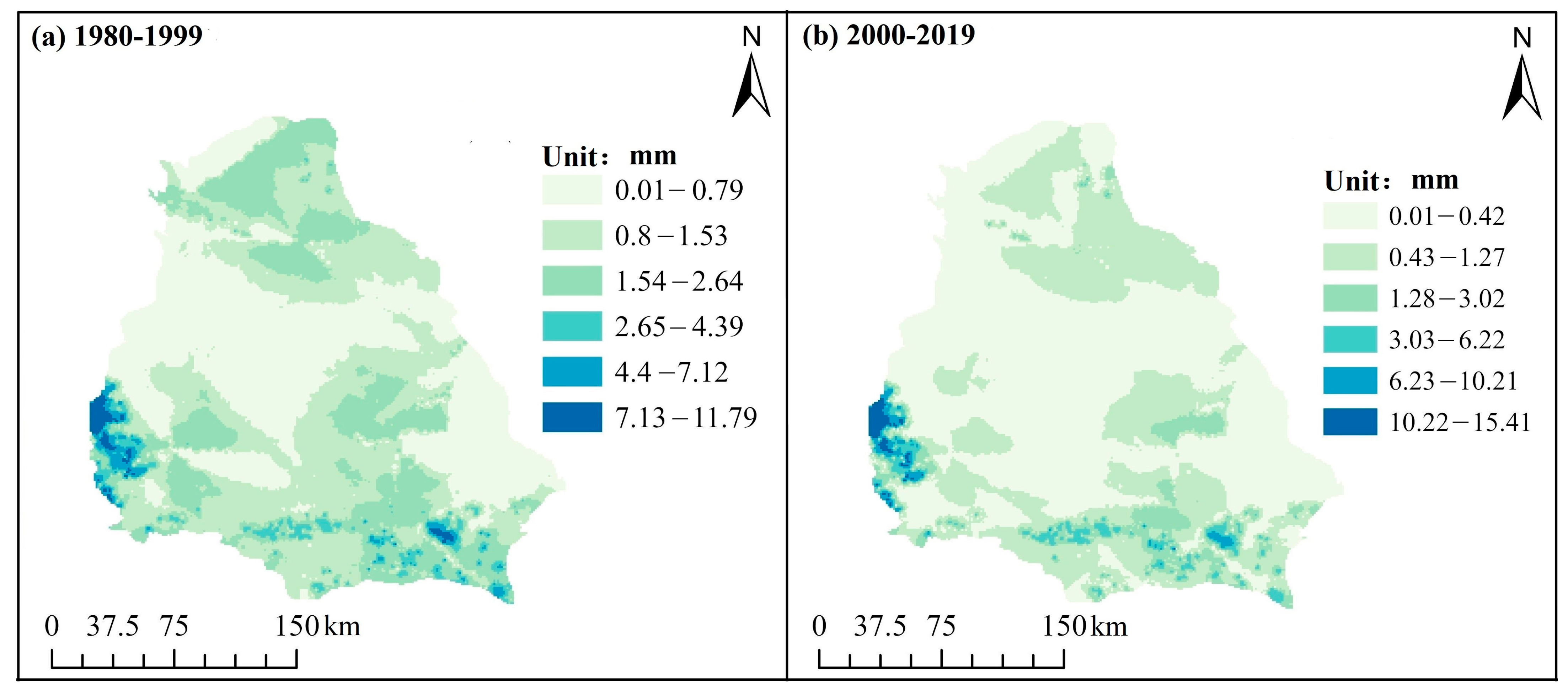
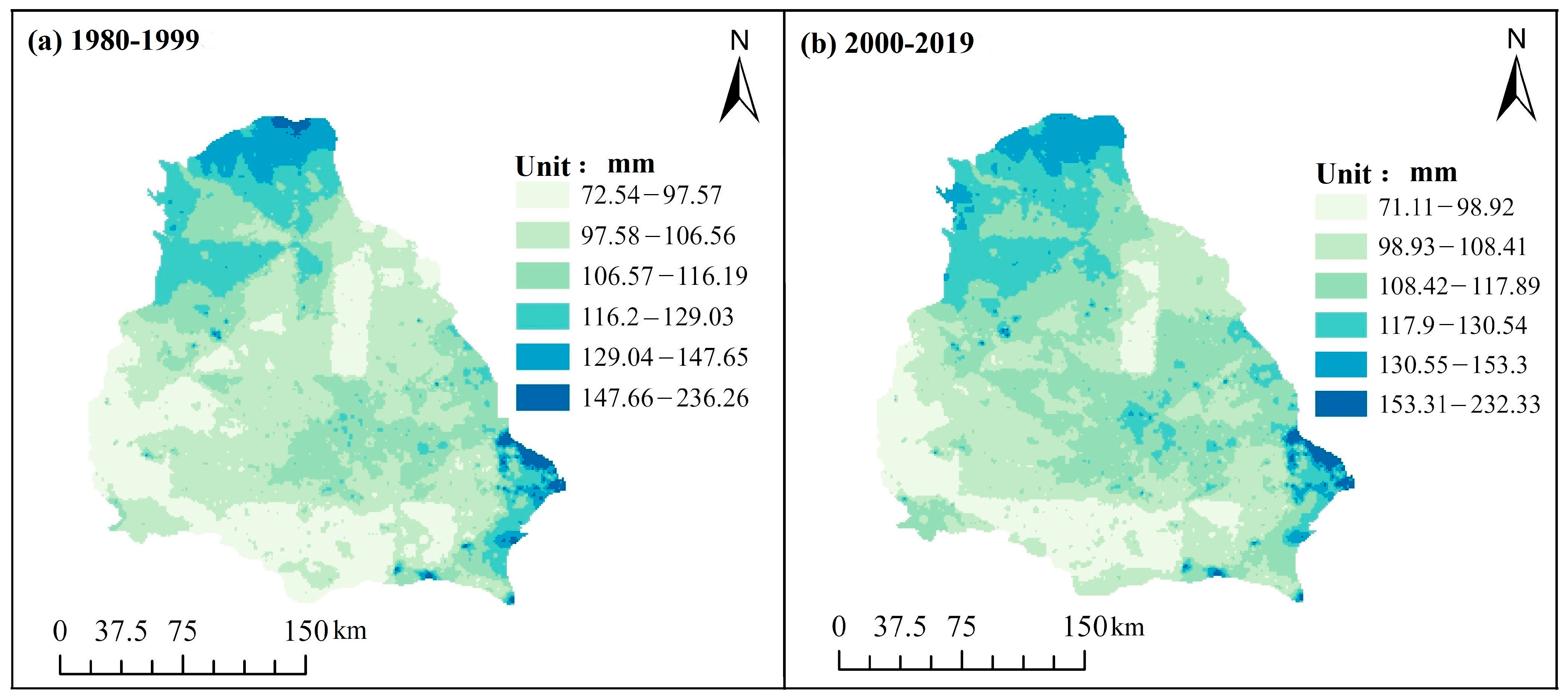

| Position | Period | Source | Quantity | Soil Depth | Measurement Method |
|---|---|---|---|---|---|
| Xifeng | 1981–1999 | International soil moisture network | 962 | 0–1 m | Soil moisture sensor |
| Huanxian | 1981–1999 | International soil moisture network | 755 | 0–2 m | Soil moisture sensor |
| Nanxiaohegou basin | 2005–2006 2016–2018 | Published literature | 404 | 0–2 m | TDR |
| Wangdonggou basin in Changwu | 2010–2015 | Published literature | 55 | 0–2 m | TDR |
| Zhifanggou basin | 2017–2019 | Published dataset | 156 | 0–2 m | TDR |
| Zhonggou basin | 2017–2019 | Published dataset | 122 | 0–2 m | TDR |
| LU | Farmland/% | Arbor/% | Shrub/% | Grass/% | Water/% | Urban/% | |
|---|---|---|---|---|---|---|---|
| Year | |||||||
| 1980 | 42.60 | 4.57 | 5.05 | 45.97 | 0.50 | 1.18 | |
| 2000 | 42.55 | 4.49 | 4.97 | 46.25 | 0.40 | 1.34 | |
| 2018 | 38.43 | 5.04 | 5.56 | 48.43 | 0.40 | 2.00 | |
| 1980 | Farmlaznd/km2 | Arbor/km2 | Shrub /km2 | Grass /km2 | Water /km2 | Urban /km2 | Total /km2 | |
|---|---|---|---|---|---|---|---|---|
| 2000 | ||||||||
| Farmland/km2 | 18,494.40 | 3.39 | 3.41 | 85.32 | 41.08 | 3.03 | 18,630.64 | |
| Arbor/km2 | 30.26 | 1914.03 | 2.16 | 17.55 | 2.28 | 0.14 | 1966.42 | |
| Shrub/km2 | 3.59 | 1.88 | 2156.80 | 12.63 | 0.40 | 0.01 | 2175.32 | |
| Grass/km2 | 46.30 | 82.83 | 100.49 | 20,006.80 | 12.97 | 0.44 | 20,249.83 | |
| Water/km2 | 7.15 | 0.05 | 0.00 | 1.64 | 161.78 | 0.02 | 170.63 | |
| Urban/km2 | 68.83 | 0.67 | 0.43 | 2.93 | 1.15 | 513.26 | 587.26 | |
| Total/km2 | 18,650.53 | 2002.85 | 2263.28 | 20,126.89 | 219.66 | 516.89 | 43,780.10 | |
| 2000 | Farmland/km2 | Arbor/km2 | Shrub /km2 | Grass /km2 | Water /km2 | Urban /km2 | Total /km2 | |
|---|---|---|---|---|---|---|---|---|
| 2018 | ||||||||
| Farmland/km2 | 12,851.00 | 165.30 | 183.32 | 3437.00 | 36.12 | 153.06 | 16,825.80 | |
| Arbor/km2 | 279.48 | 1452.28 | 65.18 | 398.59 | 2.58 | 8.55 | 2206.66 | |
| Shrub/km2 | 223.99 | 55.45 | 1615.96 | 537.78 | 0.85 | 1.49 | 2435.52 | |
| Grass/km2 | 4790.00 | 274.11 | 303.86 | 15,741.00 | 27.11 | 61.74 | 21,197.82 | |
| Water/km2 | 46.93 | 3.10 | 0.70 | 21.89 | 94.15 | 1.81 | 168.57 | |
| Urban/km2 | 412.86 | 12.76 | 2.70 | 82.94 | 6.05 | 360.20 | 877.51 | |
| Total/km2 | 18,604.26 | 1963.00 | 2171.73 | 20,219.20 | 166.85 | 586.84 | 43,780.10 | |
| Parameters | Suggestive Values | Default | Parameters | Suggestive Values | Default |
|---|---|---|---|---|---|
| Aquifer thickness correction factor | 0.1–20 | 1 | Reserve depth of woodland depression (mm) | 20–80 | 60 |
| Layer 1 soil thickness (m) | 0.1–0.8 | 0.2 | Reserve depth of grassland depression (mm) | 10–50 | 30 |
| Layer 2 soil thickness (m) (m) | 0.2–2 | 0.6 | Open depression depth (mm) | 2–20 | 10 |
| Layer 3 Soil thickness (m) (m) | 0.3–2 | 1.2 | Reserve depth of slope farmland depression (mm) | 5–30 | 15 |
| Stomatal impedance correction factor | 0.01–100 | 1 | Reservoir depth of paddy depression (mm) | 80–200 | 120 |
| Correction coefficient of river roughness | 0.2–2 | 1 | Storage depth of irrigated farmland depression (mm) | 50–120 | 80 |
| Correction coefficient of slope roughness | 0.2–2 | 1 | Reserve depth of non-irrigated farmland depression (mm) | 40–100 | 80 |
| Correction coefficient of soil saturated water conductivity | 0.01–100 | 1 | Reserve depth of basin depression (mm) | 80–300 | 110 |
| Aquifer side guide water coefficient correction coefficient | 0.1–6 | 3 | Terraced depression storage depth (mm) | 60–200 | 80 |
| Correction coefficient of river bed floor material drainage conductivity correction | 0.01–100 | 1 |
| Parameters | 1980–1999 | 2000–2019 | Parameters | 1980–1999 | 2000–2019 |
|---|---|---|---|---|---|
| Correction coefficient of aquifer thickness | 1 | 1.3 | Maximum depression storage depth of forest(mm) | 60 | 60 |
| The thickness of the first soil layer (m) | 0.2 | 0.2 | Maximum depression storage depth of grass (mm) | 30 | 30 |
| The thickness of the second soil layer (m) | 0.6 | 0.6 | Maximum depression storage depth of bare soil (mm) | 10 | 10 |
| The thickness of the third soil layer (m) | 1.2 | 1.2 | Maximum depression storage depth of cultivated hillslope (mm) | 15 | 15 |
| Correction coefficient of stomatal resistance | 1 | 0.3 | Maximum depression storage depth of paddy field (mm) | 120 | 120 |
| Correction coefficient of Manning roughness in river channel | 1 | 1 | Maximum depression storage depth of irrigated farmland (mm) | 80 | 80 |
| Correction coefficient of Manning roughness in slope | 1 | 1 | Maximum depression storage depth of non-irrigated farmland (mm) | 80 | 80 |
| Correction coefficient of saturated hydraulic conductivity | 0.8 | 1.3 | Maximum depression storage depth of check dam (mm) | 110 | 110 |
| Correction coefficient of lateral hydraulic conductivity of aquifer | 3 | 3 | Maximum depression storage depth of Terraced field (mm) | 80 | 80 |
| Correction coefficient of conductivity of river bed materials | 1 | 1 |
| Period | Model Performance Criteria | Rate Period | Verification Period |
|---|---|---|---|
| 1980–1999 | Nash–Sutcliffe efficiency coefficient | 0.72 | 0.75 |
| Coefficient of determination (R2) | 0.95 | 0.98 | |
| Relative error (Re) | 15.89% | 13.25% | |
| 2000–2019 | Nash–Sutcliffe efficiency coefficient | 0.73 | 0.70 |
| Coefficient of determination (R2) | 0.95 | 0.91 | |
| Relative error (Re) | 15.81% | 17.91% |
Disclaimer/Publisher’s Note: The statements, opinions and data contained in all publications are solely those of the individual author(s) and contributor(s) and not of MDPI and/or the editor(s). MDPI and/or the editor(s) disclaim responsibility for any injury to people or property resulting from any ideas, methods, instructions or products referred to in the content. |
© 2023 by the authors. Licensee MDPI, Basel, Switzerland. This article is an open access article distributed under the terms and conditions of the Creative Commons Attribution (CC BY) license (https://creativecommons.org/licenses/by/4.0/).
Share and Cite
Zhang, Z.; Chen, Y.; Zhang, G.; Zhang, X. Simulation of Hydrological Processes in the Jing River Basin Based on the WEP Model. Water 2023, 15, 2989. https://doi.org/10.3390/w15162989
Zhang Z, Chen Y, Zhang G, Zhang X. Simulation of Hydrological Processes in the Jing River Basin Based on the WEP Model. Water. 2023; 15(16):2989. https://doi.org/10.3390/w15162989
Chicago/Turabian StyleZhang, Zhaoxi, Yan Chen, Guodong Zhang, and Xueli Zhang. 2023. "Simulation of Hydrological Processes in the Jing River Basin Based on the WEP Model" Water 15, no. 16: 2989. https://doi.org/10.3390/w15162989




